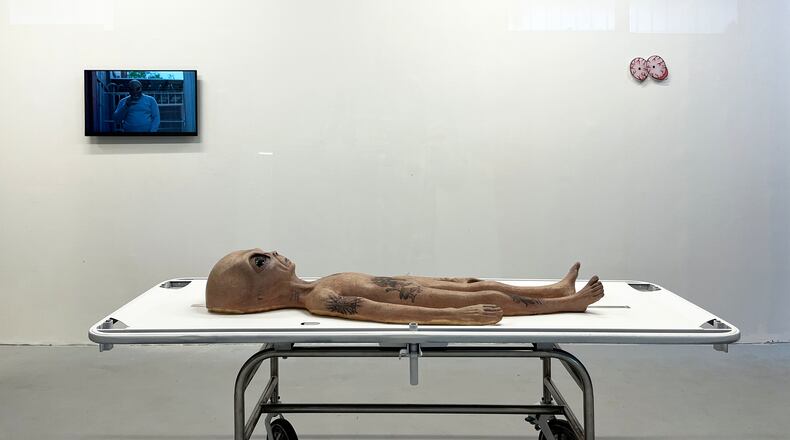If you were to picture heartbreak it probably wouldn’t look anything like Antonio Darden’s exhibition at the End Project Space.
At first glance, Darden’s solo show, titled “Rico,” appears to be something of a lark. The small gallery space is filled with irreverent pop-culture references, to SpongeBob SquarePants, “The X-Files,” alien autopsies and sci-fi special effects.
The arresting centerpiece of “Rico” is an eerily lifelike sculpture of an alien good enough to suggest a movie special effect.
That poor, lifeless spaceman lies in the center of the gallery on a hospital gurney. The creature sports the enormous head of an infant and black eyes with the reflective properties of a blank TV screen. Molded of polyurethane foam, the lifeless body feels uncannily like something formerly living and now gone. Darden has covered the alien’s skinny body and dappled brown flesh with tattoos, an incongruous touch that also invests the creature with a humanoid dimension.
The small gallery space is awash in nods to conspiracies and comics that suggest an America defined by our entertainments and paranoias. Also on view in the room: a looped video of a man in an alien mask smoking a cigarette and an acrylic sculpture “Huncho,” depicting the kind of manic, blood-shot eyes of a bugging-out cartoon character.
Credit: Handout
Credit: Handout
Like the gap between the ersatz home-like decor of a funeral home and the grittier operations that go on behind the scenes, the gallery space has been divided into that fluorescent lit alien autopsy room and the one behind a thick black curtain.
In that adjacent room is the installation “Sang James (BOJ)” which includes a podium of the kind used for sermons and speeches, rendered in plexiglass edged with neon yellow to give it a supernatural glow. A soundtrack in its base plays a gospel song, performed, it turns out, by the artist himself. On the wall, encased in a plexiglass box is a painting of a man with the heavy mustache and wide lapeled suit of a ‘70s preacher or singer — a visualization, perhaps of that unseen voice.
Credit: Handout
Credit: Handout
The irreverence seemingly contained in that jokey retro painting and those SpongeBob bloodshot cartoon eyes feels like a psychological strategy, a cover, like a cracked joke or quick change of subject.
It turns out that alien splayed out on a gurney in “Last One Left” is a stand-in for Darden’s own brother and Morehouse grad David F. Darden III, shot in 2018 by a Georgia State Patrol trooper after enduring a long struggle with mental health issues. The subsequent autopsy has only left Darden less clear about his brother’s death. The tattoos are replicas of ones David, who his family called Rico, had. Grief, it turns out, has been a constant for the 39-year-old artist and Georgia State BFA grad who has lost his mother, brother and father in succession.
Aliens and monsters have often been sci-fi’s scapegoats, the “Others” who are chased or persecuted by villagers waving torches or trigger-happy lawmen. It’s no coincidence that Darden uses an alien symbolically here to reference the violent end of a loved one, an all too familiar circumstance for Black Americans.
Credit: Handout
Credit: Handout
But “Rico” is also about a world that denies Black victims their humanity in the first place. Cue the absurdity as coping strategy and rage against a surreal state of affairs.
There is a sadness in the collision of elements from TV and cartoons in “Rico” with the real-world traumas of death and loss. “Rico” taps into a fertile image bank of childhood iconography from cartoons and movies, mashed up against the grim reality of adulthood and innocence lost.
VISUAL ART REVIEW
“Rico”
Through August 28. Noon-4 p.m. Fridays and Saturdays and by appointment. Free. The End Project Space, 1870 Murphy Ave. SW, Atlanta. instagram.com/the_end_project_space, acdrennen@gmail.com.
Bottom line: Laced with jokey absurdity, this solo show in fact conjures up the sensation of grief, when the world feels surreal and upside down and you’ll do anything to change the subject.
About the Author
Keep Reading
The Latest
Featured





